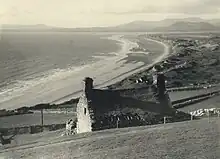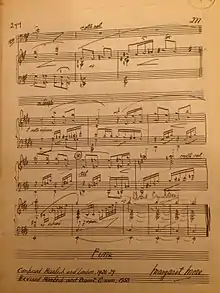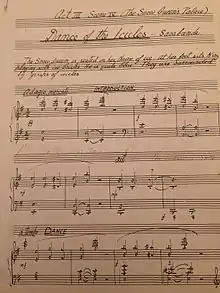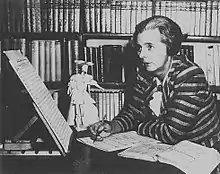Margaret More (composer)
Early years
Margaret More, often called "Peggy",[3] was born in 1903 to English parents William and Alice More[4] in Crown Lodge in Harlech, North Wales. Her interest in music showed early, but she was not an infant prodigy. It became clear that her main concern was composition; she had no interest whatever in a career as a performer. She was educated at home by a governess, who gave her a grounding in musical theory and encouraged her ambition.
In her early teen-years More became friends with the composer Joseph Holbrooke who at that time was living in Harlech. He introduced her to the work of Debussy and gave her the recently published Préludes and Children's Corner. These had a lasting effect on More's own work. It was also through Holbrooke that she met her future husband Raymond Bantock, who was a writer.[3]
Career
In the mid-1920s Margaret More left Harlech to spend a year in London, where she attended Trinity College of Music and studied composition with Edward d'Evry. It was while living in London that she met poet Claudine Currey, who later became the mother-in-law of More's brother, Jack. Currey had recently written a libretto, The Little Mermaid (pub. Elkin Mathews 1925), based on the 1837 Hans Christian Andersen story, The Sea Maid, and this became the starting point for More's first major work, a grand opera: The Mermaid. She collaborated with the librettist for several years and the opera was finished, unorchestrated and unperformed, in 1929. More would frequently play parts of the work to invited audiences of friends, however. The opera was finally orchestrated in 1950 and performed in its entirety in 1951 by the Barfield Grand Opera Society in Birmingham, as part of the city's contribution to the Festival of Britain.[5][6][7][8]

More was called back to Harlech in 1926 to care for her mother, who died the following year. She continued to live at Crown Lodge until she married Raymond Bantock, second son of the composer Granville Bantock, in 1930.[9] Thereafter she spent most of her life in the Midlands at Barnt Green, near Birmingham, where she raised her family. Contact with Harlech was maintained through summer holidays spent at Traethdy in the dunes. Later she restored a stone cottage, Hen Gaerffynnon, to the south of Harlech where she was able to compose in solitude.
During the 1930s and early 1940s the Bantocks raised a family of six children, including Gavin Bantock, a poet. Music took second place but she composed Matris Carmina, a suite of six works for piano and recorder, each piece dedicated to a particular child. During the war the family returned to Harlech for three years, living at Traethdy. The composer ran a school in the village and wrote music for school concerts and a Christmas performance n the Memorial Hall.
In the mid-1940s More returned full strength to music. Her sister-in-law, Myrrha Hawkes, at that time living in South Africa, invited her to compose music for a children's Christmas entertainment based on Hans Andersen's story: The Snow Queen. The story was dramatized and the lyrics written by Michael Martin-Harvey, the son of the actor Sir John Martin-Harvey. Michael Martin-Harvey had been an old friend of Raymond Bantock's, dating from Oxford in the 1920s. This new work was performed during several Christmas seasons in Johannesburg in the late 1940s.
In 1955 the "Sarabande" from this work was awarded first and second prize in the Cheltenham Festival.
Hans Andersen Players
In 1955, More and Martin-Harvey founded the Hans Andersen Players. The idea behind this new departure was based on an early engraving of Andersen reading one of his stories at a table, with listeners sitting round in semi-circle. The image was re-interpreted with Martin-Harvey dressed as Andersen as narrator, with singers, in costume, seated on either side. Martin-Harvey wrote the lyrics and freely adapted the stories for this new art form. Margaret More composed the music for piano, which she played on stage.
The first work to be performed by the Players was a re-casting of The Snow Queen, with its debut in Birmingham, in 1955. Other stories that were adapted over the next few years were The Nightingale, The Swineherd, Old Lukoie, It’s Quite True, Punchinello, and Five out of One Pod. The Players performed widely at a range of venues in the Midlands and in Berkshire where Martin-Harvey lived: the Birmingham Repertory Theatre, the Birmingham and Midland Institute and The Birmingham Theatre School, as well as various school halls, village halls and theatres. In 1957 the Players were invited to tour Denmark through the aegis of the Danish Consulate in Birmingham. The tour involved several weeks and most of the larger towns in the country, which much of the time spent in Aarhus.
More's main forte as a composer was work for voice. She composed away from the piano, and as with many songwriters, wrote with a particular singer's voice in mind. A late work, Anthem, is for unaccompanied voice and is a memorial to her fourth son who died in 1957.
Her last major work, The Mouse, was a setting from one of one of the stories from the Welsh folk lore The Mabinogion. The libretto was by Amabel Williams-Ellis of Portmeirion and the work was first performed by the Players in Coleg Harlech and Portmeirion in 1958. The composer later re-cast the music as a dramatic lay, as 70 minutes of continuous song, without narration.
Death
Margaret More died in 1966. The Players continued their work for a few years, performing in Nottingham and Bristol. The Mouse was performed posthumously several times at the family home in Barnt Green, produced by her fifth son Gavin and costumed by her third son Cuillin.
List of Principal Works
| Title | Libretto | Instrumentation | Year Composed |
|---|---|---|---|
| The Mermaid | Claudine Currey | (i) Orchestra and Voice | 1928-29, 1950 |
| The Mermaid | (ii) Piano and Voice | 1950 | |
| The Mermaid | (iii) Prelude arrangement for four
hands |
Not Known | |
| The Mermaid | (iv) Mermaids' Chorus arrangement
for piano solo |
1952 |

| Title | Libretto | Instrumentation | Year Composed |
|---|---|---|---|
| The Shepherd of Myddfai | Christopher Casson | (i) Small Orchestra | c.1945 |
| The Shepherd of Myddfai | (ii) Piano solo | Not known | |
| Medium in White | Myrrha Bantock | Piano | 1947 |
| Title | Libretto | Instrumentation | Year Composed |
|---|---|---|---|
| The Snow Queen | Michael Martin-Harvey | (i) Small Orchestra | 1948 |
| The Snow Queen | (ii) Piano Solo | 1948 | |
| The Snow Queen | (iii) Excerpts for solo piano,
two pianos & piano |
c.1950 |

| Title | Libretto | Instrumentation | Year Composed |
|---|---|---|---|
| The Mouse | Annabel Williams - Ellis | Voice, Piano, Narrator | 1956-57 |
| The Mouse | Recast without Narrator | c.1960 |
| Title | Words | Instrumentation | Year Composed |
|---|---|---|---|
| Anthem | Rufus Ellis | (i) Choir & Organ | 1959 |
| Anthem | (ii) Arrangement for unaccompanied voice | c. 1961 | |
| Forward | Margaret More
(under pseudonym of William Novis) |
(i) Mixed voices and orchestra | 1951 |
| Forward | (ii) arrangement for voice & piano | 1951 |
Other works
The Players
Eight arrangements of Hans Andersen stories for Voice, Piano and Narrator between 1955 and 1960
Five out of One Pod,
It’s Quite True!,
Old Luk Oje,
Punchinello,
The Nightingale,
The Princess of the Pea,
The Snow Queen,
The Swineherd
Pianoforte Solo
Nine works composed between 1918 and 1927
Berceuse,
By Moonlight,
Four Myths,
Four Poems,
Harlequin and Columbine (published),
Heather,
Nocturne (published),
Piano Piece No 1,
Sunrise.
Chamber Music
Piano Quartet - Piano, Violin, Viola, Cello - 1932
Piano Trio - Piano, Violin, Cello - 1936
All of Margaret Mores music currently resides in the archive of the Library of Birmingham.
References
- "Margaret More 1903-1966". Unsung Composers. Retrieved 21 August 2017.
- Grove’s Dictionary of Music and Musicians, 5th Edition, E.B., 1954, page 887.
- "Raymond Bantock Collection". Archives Hub. Retrieved 21 August 2017.
- "GB's Grandparents". Gavin Bantock official website. Retrieved 21 August 2017.
- Birmingham Gazette, 1 August 1951: "Mother of Six Completes Opera".
- Birmingham Mail, 5 September 1951: "New British Opera – The Mermaid at Moseley".
- Daily Telegraph, 6 September 1951: "Opera based on Fairy Tale"
- Birmingham Despatch, 6 September 1951: "New Opera is a Success".
- Martin Powell (12 April 2015). "Anton Bantock obituary". The Guardian. Retrieved 21 August 2017.
Further reading
- British Music Society News No 99: Margaret More. March 2003, Cuillin Bantock
- British Music Society News No 101: Margaret More. March 2004, Rob Barnett (Ed)
- Listing of The Mermaid courtesy of the British Library
